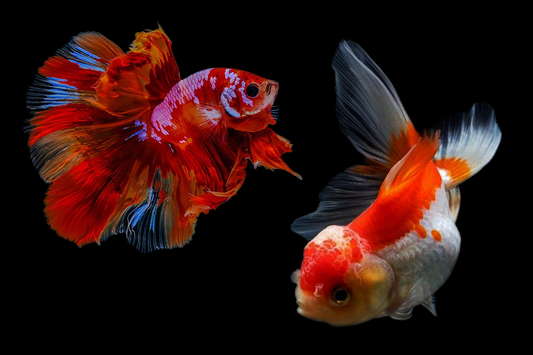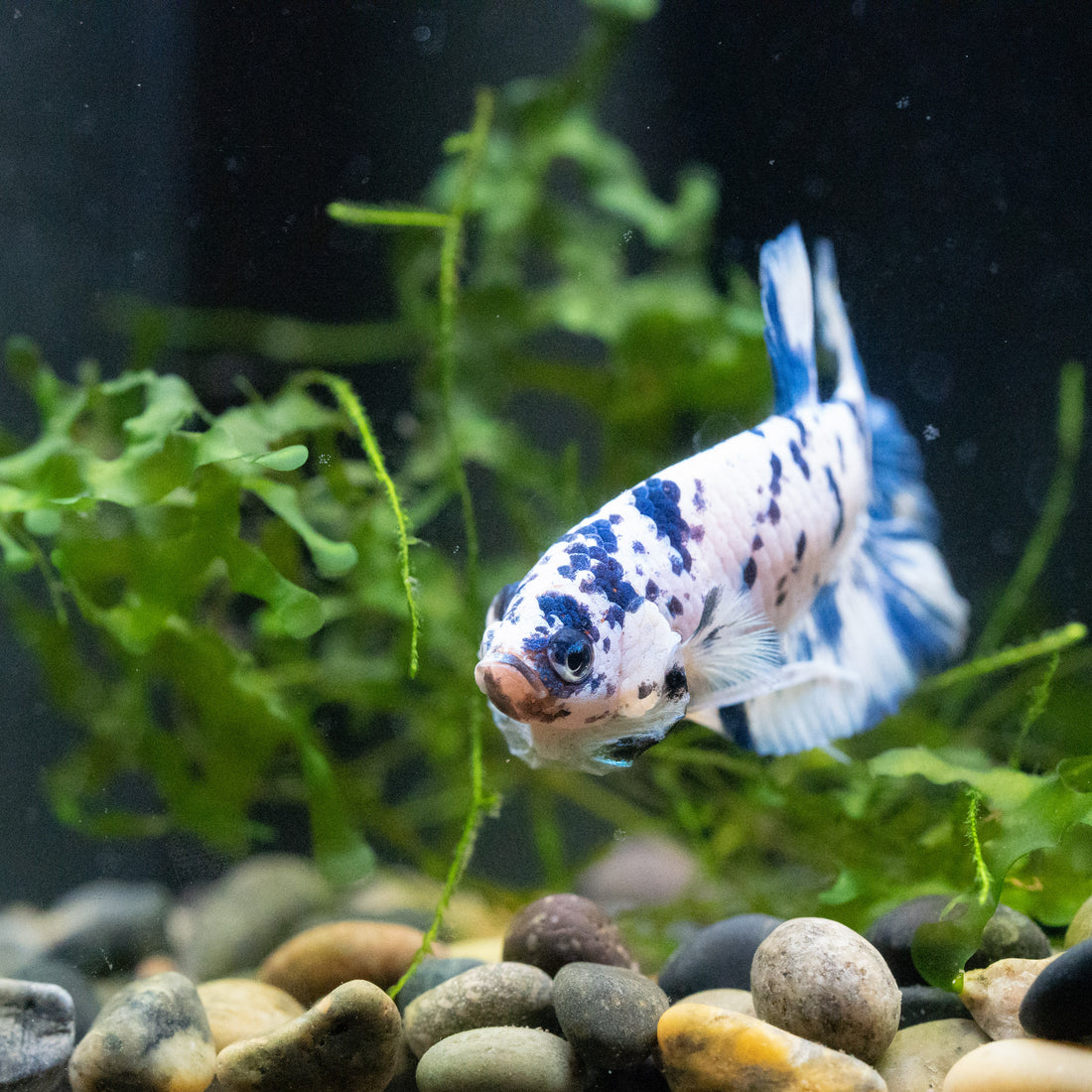Blue Marble Dot Overview
Blue Marble Dot Betta fish are renowned for their stunning blue marbling and unique dot patterns on their bodies, making them a captivating addition to any level of betta fish keeping. In this article, we will delve into everything related to Marble Betta fish to assist you in caring for these beautiful aquatic companions.

Origin of Marble Betta Fish
Origin
Orville Gulley, a prison inmate, is credited with creating the Marble Betta fish. While raising his bettas in empty peanut butter jars, he unintentionally stumbled upon the marble gene while attempting to breed a black butterfly betta. Impressed by this new strain, Gulley shared some of his fish with renowned betta enthusiast and author Walt Maurus, along with other breeders. Their admiration led to dedicated breeding efforts aimed at enhancing and preserving the captivating marble pattern.
The First Look of Marble Betta Fish

Female Blue Marble Dot Betta
Marble Betta fish resemble the pinto horses in the betta fish world, characterized by dark, solid-colored blotches on a white or flesh-colored body, or vice versa. While originally primarily black and white, this strain has evolved over time to encompass a wide spectrum of colors. Throughout their evolution, Marble Betta fish have played a pivotal role in influencing the creation of numerous new color variations within the betta fish world.
Why Marble Dot Betta Fish Changes Color
What is Jumping Gene
“Jumping genes” have the capacity to relocate within an organism's chromosomes, occasionally affecting gene expression. This can temporarily disrupt specific cellular functions, but the gene's presence in a chromosome is also temporary, leading to temporary interference with genetic expression. This concept is relevant to the marbling of Betta fish as it offers insights into why some Marble Betta fish never exhibit marbling patterns. If the 'jumping gene' fails to integrate (as in dark-bodied fish) or doesn't dislodge (as observed in light-bodied fish) within the fish's cells during its growth or lifetime, marbling will not occur. This principle can also apply to other pigment production, such as blue, green, steel blue, and red pigments.
How it Relates to Marble Betta Fish
'Jumping genes' may insert themselves into genes responsible for these pigments, either activating or deactivating pigment production in groups of developing cells within the maturing fish. This is why Marble Betta fish often undergo color changes over time.
Blue Marble Dot Appearance
Blue Marble Dot Moo Cow Betta fish typically feature a marbled pattern with vibrant blue hues and unique dot markings on their bodies. They come with both plakat (short tail) and long tail (halfmoon tail)

Halfmoon Blue Marble Dot Betta
How Much Marble Dot Cost
The cost of a Blue Marble Dot Moo Cow Betta fish can vary depending on factors like the breeder or seller, the fish's age, coloration, and overall quality. On average, you can expect to pay anywhere from $20 to $30 for a Blue Marble Dot Moo Cow betta. However, exceptionally high-quality or rare variations of this betta type may command higher prices.
How to Take Care of Blue Marble Dot Bettas
Tank Size
Like other Betta fish, Marble Dot Bettas require a 5-gallon tank at a minimum, but 10 gallons are preferable. If you're considering a male and female pair, a 10-gallon tank can accommodate them comfortably.
Water Temperature & pH
Blue Marble Dot fish thrive in tropical conditions, typically within a temperature range of 77–86˚F. They also prefer slightly acidic water, with some enthusiasts suggesting a pH as low as 4.5. However, a more common recommendation is maintaining a pH level between 5.0 and 6.5, as long as the pH remains stable.
Plants
Blue Marble Dot Betta fish tend to appreciate a well-planted tank, particularly with plants sporting large, broad leaves. Opt for plants that thrive in the soft, acidic water environment preferred by betta fish, such as Anubias and Java ferns.
Lighting
There are no specific lighting requirements beyond a regular day/night cycle. Natural lighting often suffices for Blue Marble Dot Betta tanks. Ensure that the tank's lighting is adequate to support plant growth.
Food and Diet
Proper nutrition is essential for the health and vibrancy of your Marble Dot Betta fish. These captivating bettas thrive on a diet that includes high-quality betta pellets, live or frozen foods like brine shrimp, daphnia, and bloodworms, as well as occasional treats of freeze-dried or dried foods.
Keeping Your Blue Marble Dot Betta Fish Healthy
The most common health issue observed in Blue Marble Dot Betta fish relates to water quality problems, which can lead to conditions such as parasitic infections (e.g., ich) or bacterial and fungal ailments (e.g., fin rot). To prevent these issues, it's crucial to maintain excellent water quality in the tank by performing regular water changes and diligently monitoring water parameters, in addition to maintaining stable pH and temperature levels.
Another prevalent health concern among Blue Marble Dot Betta fish pertains to digestive problems, including constipation and related digestive issues that can occasionally lead to fatalities. Ensuring that your Marble Betta receives a high-quality diet devoid of inappropriate foods is essential for maintaining a healthy digestive system.
Breeding Marble Betta Fish
Breeding Blue Marble Dot Betta fish is best done in a separate breeding tank rather than their regular habitat. These fish are paternal mouthbrooders, with the males carrying fertilized eggs in their mouths until they hatch. After the spawning process, the male collects the fertilized eggs into his mouth. If any eggs remain unattended, the female may assist by pushing them toward the male. It's important to note that the female won't participate further in caring for the eggs or fry.
During the period when the male carries the eggs, he may become protective and less tolerant of any inquisitive tankmates, particularly other Marble Betta fish, including the female. After a few days, when the eggs begin to hatch, the male will allow the fry to swim out from his mouth. The newly hatched fry will start feeding shortly thereafter and can be offered tiny foods like atermia and baby brine shrimp. Lastly, it's worth noting that after a breeding period, male Blue Marble Dot Betta fish often undergo a change in color.
Where to Buy The Blue Marble Dot
When it comes to purchasing Blue Marble Dot Betta fish, Tropicflow stands as a reputable and trustworthy source for both female and male specimens. Offering a 100% live arrival guarantee, Tropicflow provides you with the peace of mind you need when adding these exquisite marble dots to your aquarium.
Conclusion
Blue Marble Dot Betta fish are truly remarkable aquatic companions for both breeders and betta fish keepers, carrying the marble gene with unexpected colors. Their striking appearance, diverse color patterns, and captivating dots make them a standout choice for betta enthusiasts.












comment